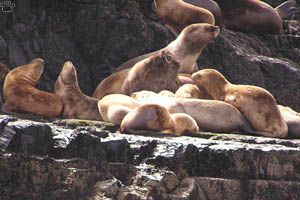
South American sea lions (Otaria flavescens), Tierra del
Fuego.
Part 6: South America
Some of the best places for viewing marine mammals are located
around South America, from Ecuador and the Amazon in the north to Tierra
del Fuego in the south.
 Swallow-tailed gull (Larus furcatus) on the
Swallow-tailed gull (Larus furcatus) on the
coast of Santa Cruz Island, Islas Galapagos. |
Western coast
of South America is almost a mirror image of North America's Pacific coast, but
the cold current is stronger here - it reaches the Equator, allowing penguins,
sea lions and fur seals to breed on Galapagos Islands. |
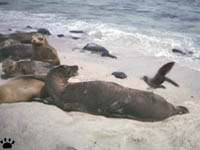 Galapagos subspecies of California sea lions
Galapagos subspecies of California sea lions
(Z. c. wollebaeki), Santa Cruz Island. |
 Galapagos fur seals (Arctocephalus
Galapagos fur seals (Arctocephalus
galapagoensis), Isla Baltra. |
In addition to very "touristic" seals
and sea lions, the Galapagos have many rare cetaceans, but most of time you only
see two widespread species there: tropical bottlenose (T. aduncus) and
long-billed common (D. capensis) dolphins. |
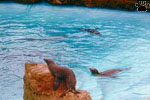 Galapagos fur seals (Arctocephalus
Galapagos fur seals (Arctocephalus
galapagoensis), Isla Baltra. |
 A few species of Mesoplodon beaked whales can be seen in
deep channels between the Galapagos Islands, but are difficult to identify at
sea. The ones on the picture are probably M. densirostris,
A few species of Mesoplodon beaked whales can be seen in
deep channels between the Galapagos Islands, but are difficult to identify at
sea. The ones on the picture are probably M. densirostris,
I think I also saw M. hectori there. Islas Playas. |
A trip to Isla de la Plata off Ecuador
is a cheaper chance to see some Galapagos fauna, as well as pantropical spotted
dolphins (Stenella attenuata) and humpbacks. |
 Humpback whales show up off Ecuador during
Humpback whales show up off Ecuador during
Austral winter. Here they can be seen breaching
more often than on feeding grounds at higher
latitudes. This population has particularly high
number of white humpbacks. Isla de la Plata. |
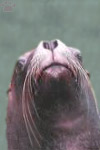 South American sea
South American sea
lion, Pisco, Peru. |
Islands further
south are also interesting. The most accessible are Islas Ballenas, visible from
Peruvian coast. They are famous for immense seabird colonies, and for large numbers
of South American sea lions. Beaked whales (probably M. peruvianus) can
be seen here close to shore. A trip to Juan Fernandez Islands, off Chile, is a
chance to see Bryde's whale (Balaenoptera edeni), more Mesoplodon
beaked whales, endemic Juan Fernandez fur seal (A. philippi), and many
rare seabirds. |
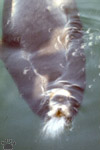 South American sea
South American sea
lion,
Pisco, Peru. |
 Sea caves under Islas Ballenas, Peru.
Sea caves under Islas Ballenas, Peru. |
I got to Juan Fernandez Islands by
hitchhiking on a Chilean Navy cruiser, so I was not allowed to take any pictures
during the crossing or our one-hour stay there (which I spent running around the
island in search of endemic birds). The photo to the right was the only one I
managed to take. |
 Juan Fernandez fur
Juan Fernandez fur
seal, Mas a Tierra I. |

|
 |
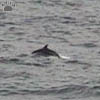 |
 |
 |
 |
| Dolphins of Chilean Channels, left
to right: dusky (Lagenorhynchus obscurus, 2 photos), hourglass (L. cruciger),
black (Cephalorhynchus eutropia), Peale's (L. australis, 2 photos).
Beagle Channel, Tierra del Fuego. |
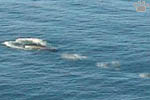 Pygmy right whale (Caperea
Pygmy right whale (Caperea
marginata) is one of the world's rarest
cetaceans. This is probably the only
photo in the wild. Beagle Channel |
The Chilean
Channels, a vast labyrinth of islands and fjords stretching from Puerto Montt
to Tierra del Fuego, is the best place to see some endemic cetaceans, such as
black dolphin (above), and porpoises (Phocoena spinipinnis, Phocoenoides dioptrica). |
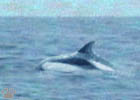 Peale's dolphin (L. australis) is one
Peale's dolphin (L. australis) is one
of the two most common species of
the Chilean Channels (the other
being bottlenose dolphin). |
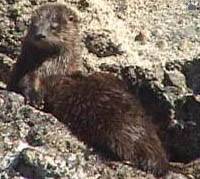
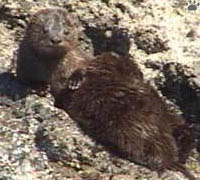
Southern marine otter, Isla Chiloe. |
The cutest inhabitant of the Chilean
Channels is southern marine otter (Lontra felina), locally known as chonguigo.
It is the world's smallest marine mammal, the size of a large housecat. Ecologically,
it resembles sea otter (see previous pages), with its love for kelp beds and rocky
shores. Pinguineria Pinihuil on the northwestern side of Isla Chiloe is probably
the most reliable place to see the otters, better in late afternoon at high tide.
|
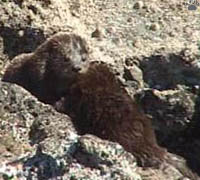 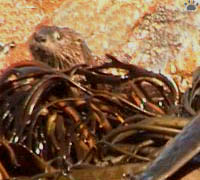
Southern marine otter, Isla Chiloe. |
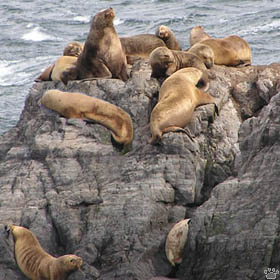
South American sea lions, Beagle Channel. |
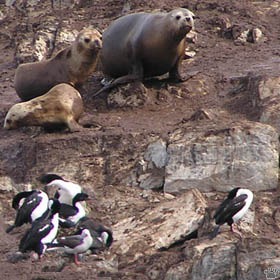
Sea lions and imperial shags (Phalacrocorax atriceps), Beagle
Ch. |
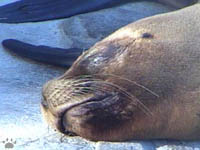 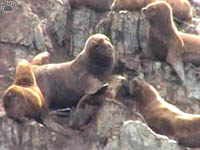
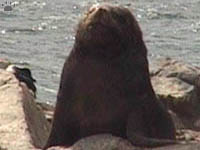
South American sea lions, Beagle Channel. |
South American sea lions are the
most common pinnipedes on South American coasts. Large colonies exist everywhere
from Peru and Uruguay to Tierra del Fuego and the Falklands. The easiest places
to see them are Valdivia in Chile and Islas Lobos near Ushuaia, Argentina. The
most predatory of eared seals, they often hunt penguins and other seabirds. Males
can be very aggressive - be extremely careful if swimming with them. Their local
name lobos marinos de un pelo, "sea wolfs with one coat", refers
to lack of undercoat, unlike in lobos marinos de dos pelos - the fur seals. |
  
South American sea lions, Beagle Channel. |

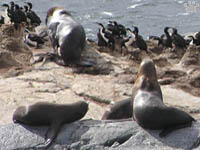
South American fur seals, Beagle Channel. |
South American fur seals (A.
australis) are slightly more difficult to see, because they have smaller range,
and their colonies are often on inaccessible rocky coasts. They can be seen together
with sea lions and many seabirds on boat trips from Ushuaia. Larger colonies are
scattered in Puerto Natales area of Chile, along the coasts of Argenitnian Patagonia
and on the Falkland Islands. |
 
South American fur seals, Beagle Channel. |

Southern elephant seals (Mirouga leonina),
Valdez Peninsula. |
On the Atlantic
side of South America, Valdez Peninsula is the most popular place to look for
marine mammals. |

Coast of Valdez Peninsula,
Argentina. |

Southern
right whale, Valdez Peninsula. |
Southern right whales (Balaena australis),
Southern elephant seals and killer whales can be seen here in spring. |

Southern
right whale, Valdez Peninsula. |

Commerson's dolphin,
San Julian. |
Franciscana (Pontoporia blainvilei) occurs further north. Boats out
of Mar del Plata, Argentina, provide a good chance to see this unusual dolphin.
In summer they are sometimes seen from ferries between Buenos Aires and Uruguayan cities, but the chances are not very good. These animals are almost impossible to photograph. |
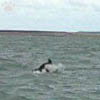
Commerson's dolphin,
San Julian. |

|
 |
 |
| Amazon river dolphin (Inia geoffrensis), Rio Yacuma, Bolivia. |
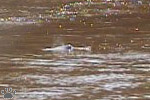
Pink river dolphin, Rio Yacuma,
Bolivia. |
In the Amazon, you can see two species of dolphins. Pink, or Amazon, river dolphin (juveniles are grey) is locally called boto, bufeo, or tonina. It also occurs in Orinoco River. It can survive in very small streams during the dry season. |
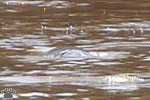
Juvenile pink river dolphin,
Rio Yacuma. |
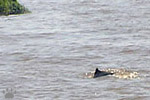
Freshwater dolphin (Sotalia
fluviatilis), Rio Solimois, Brazil. |
The tiny freshwater dolphin, or tucuxi, lives only in the largest rivers of the Amazon Basin, mostly at river confluences. Unlike the pink dolphin, it has recent marine origin, and a very close marine relative called Guyana dolphin. |
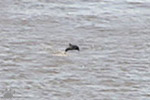
Freshwater dolphin,
Rio Solimois. |
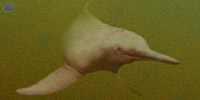
Pink river dolphin in a flooded forest, Mamiraua
Sustainable Development Reserve, Brazil. |
Guyana dolphins live along the coast from Honduras to Brazil, but are the most common in river mouths of eastern Venezuela and the Guianas. |
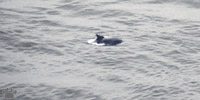
Guyana dolphin (S. guyanensis),
Georgetown, Guyana. |
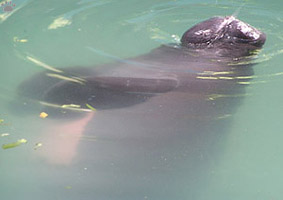
|
 |
| Amazonian manatee (Trichechus inunguis), Mamiraua Sustainable Development Reserve, Brazil. |
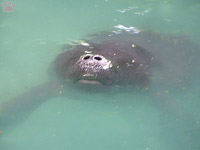
Amazonian manatee, Mamiraua SDR, Brazil. |
Amazonian manatee is very rare. Unlike other manatee species, it is black with white belly. Remnant populations in remote parts of the Amazon are threatened by illegal hunting. |
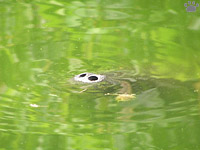
Amazonian manatee, Mamiraua SDR, Brazil. |
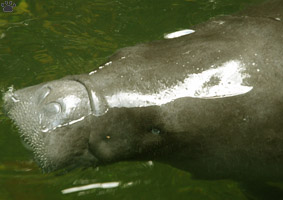
|
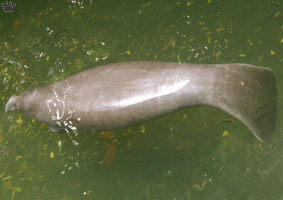 |
| Amazonian manatee, Mamiraua SDR, Brazil. |
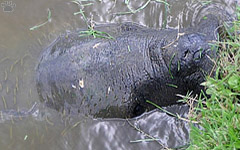
Caribbean manatee, Georgetown, Guyana. |
Caribbean manatee is larger, and still locally common along the Guyana coast. |
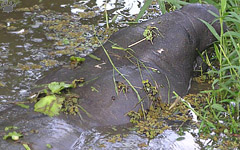
Caribbean manatee, Georgetown, Guyana. |

Caribbean manatee (T. manatus manatus), Georgetown, Guyana. |
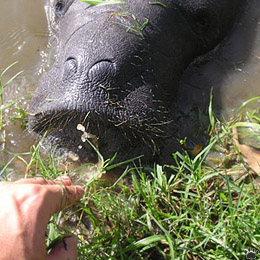
Caribbean manatee, Georgetown, Guyana. |
It can live in both salt and fresh water. |

Manatees have incredibly flexible lips. Georgetown. |

Dry season haze at Rio Manu, Peru. |
Part 7: The Antarctic
Back to Part 5
Home
|